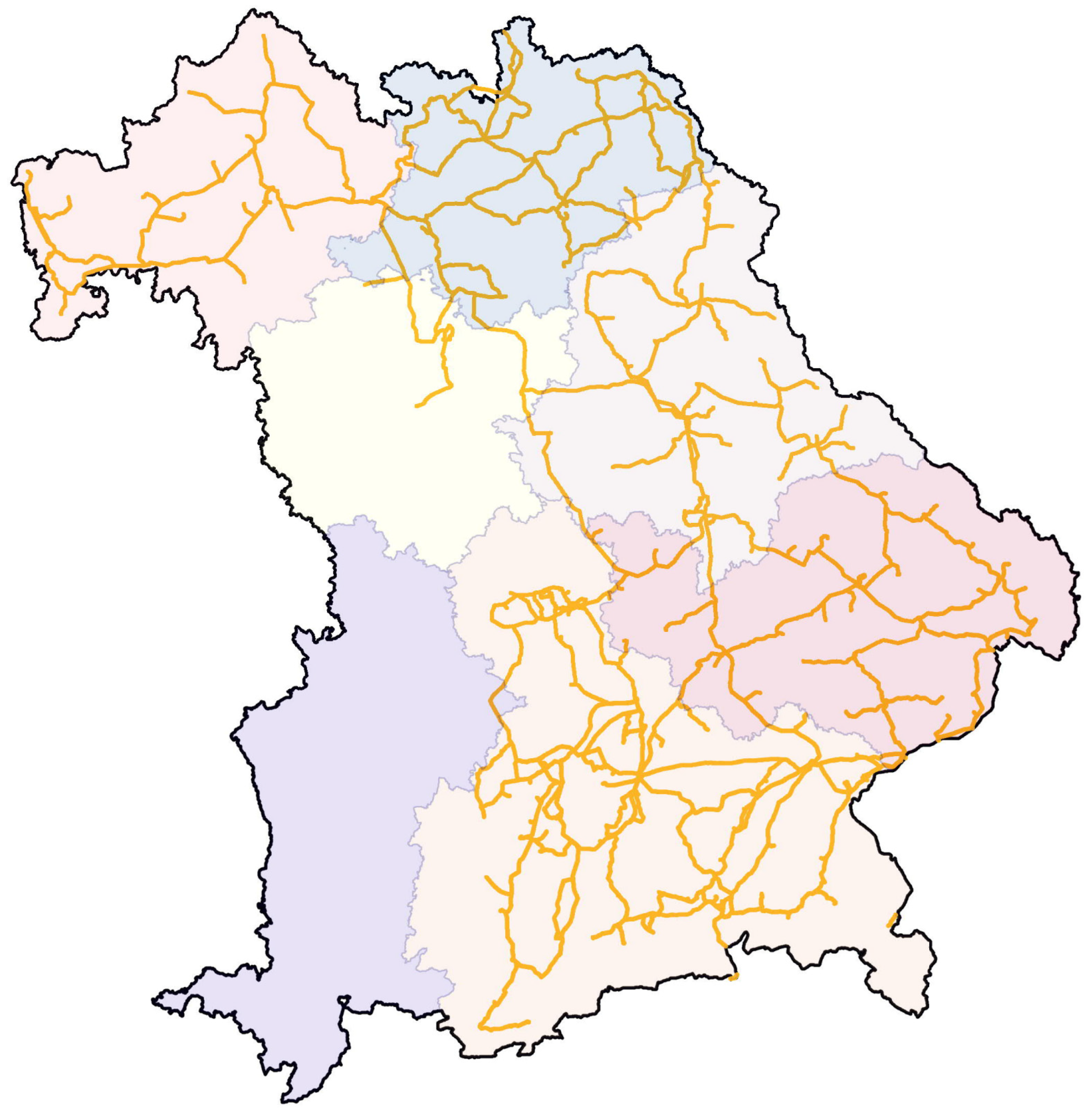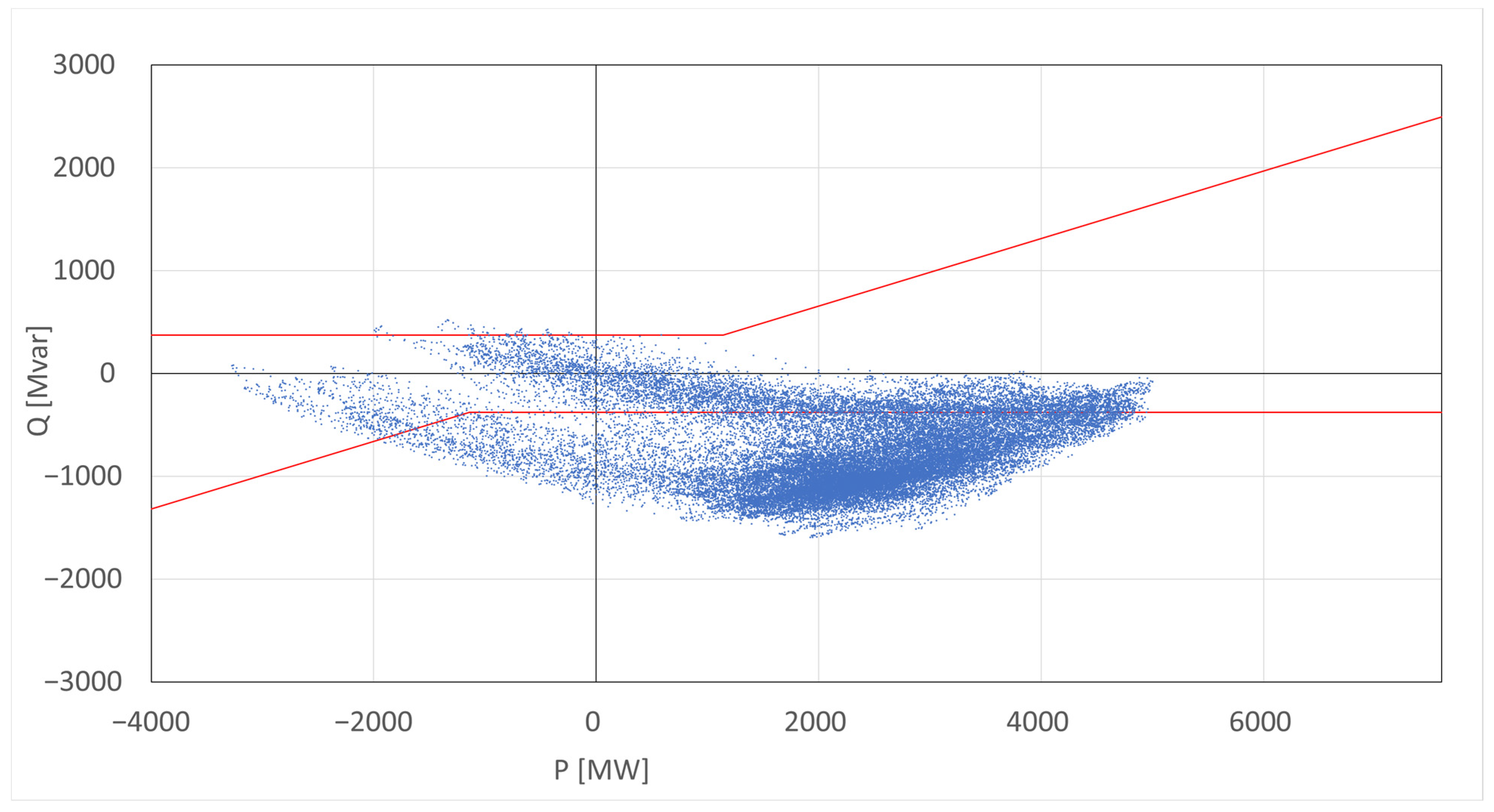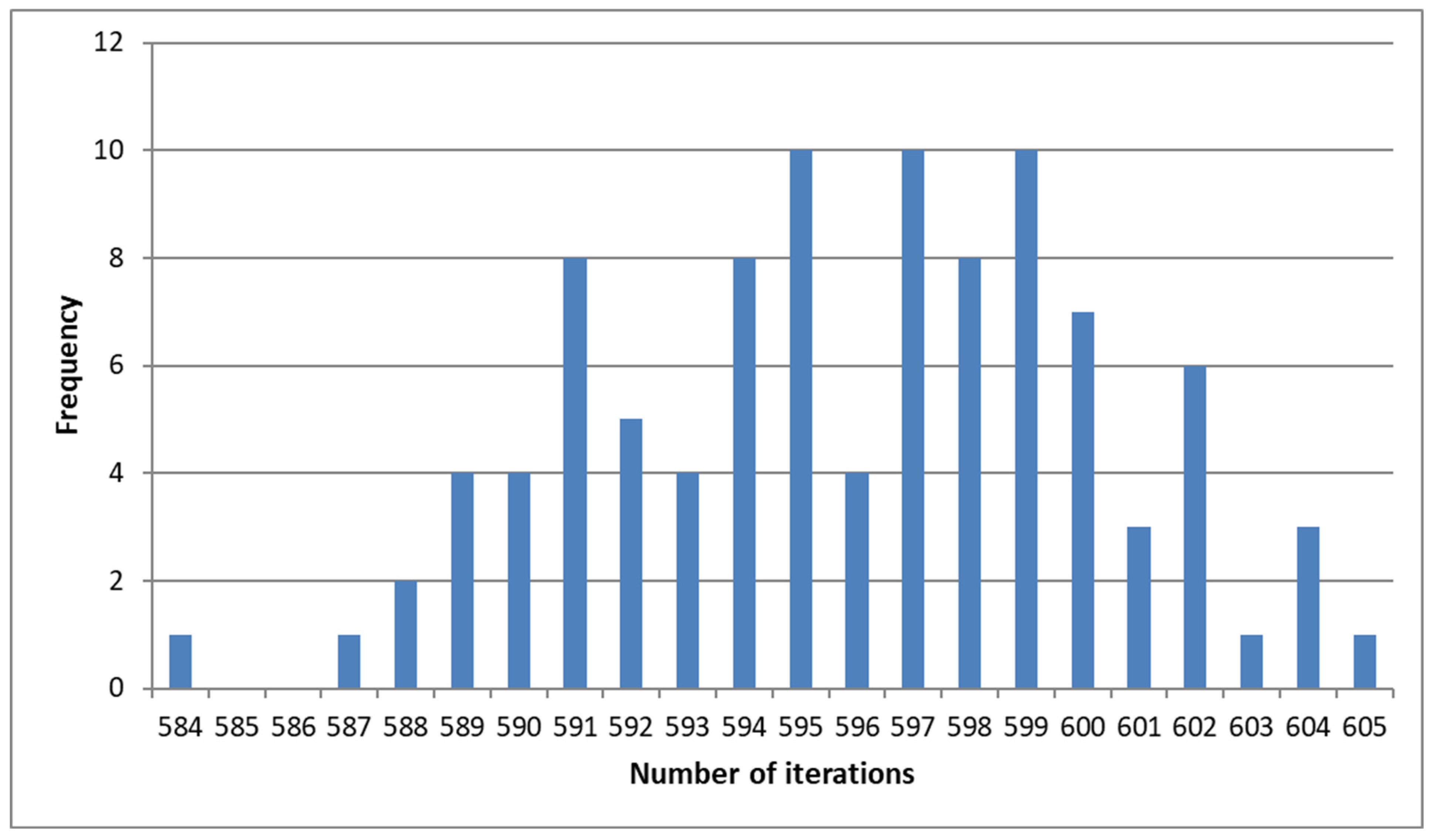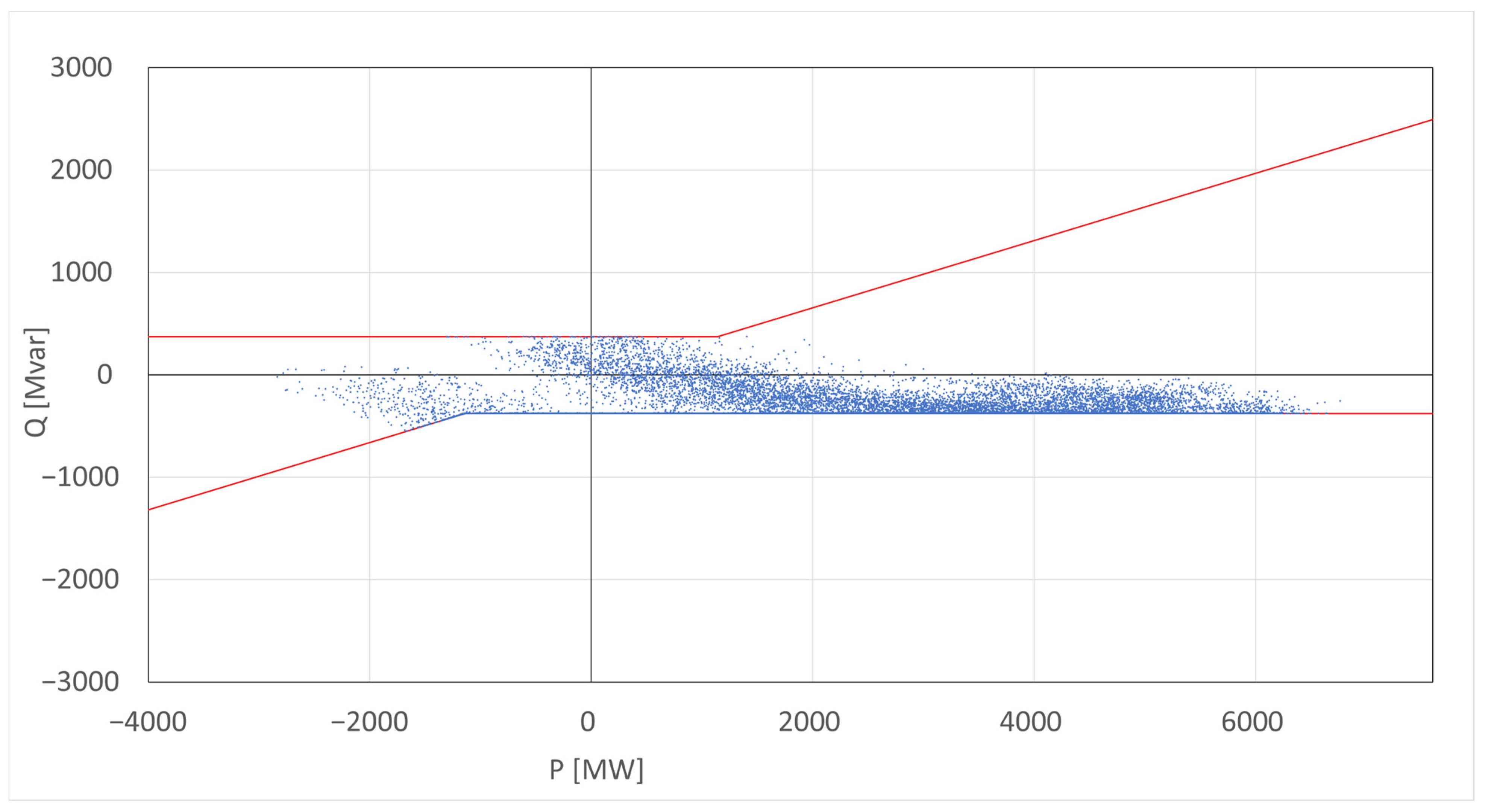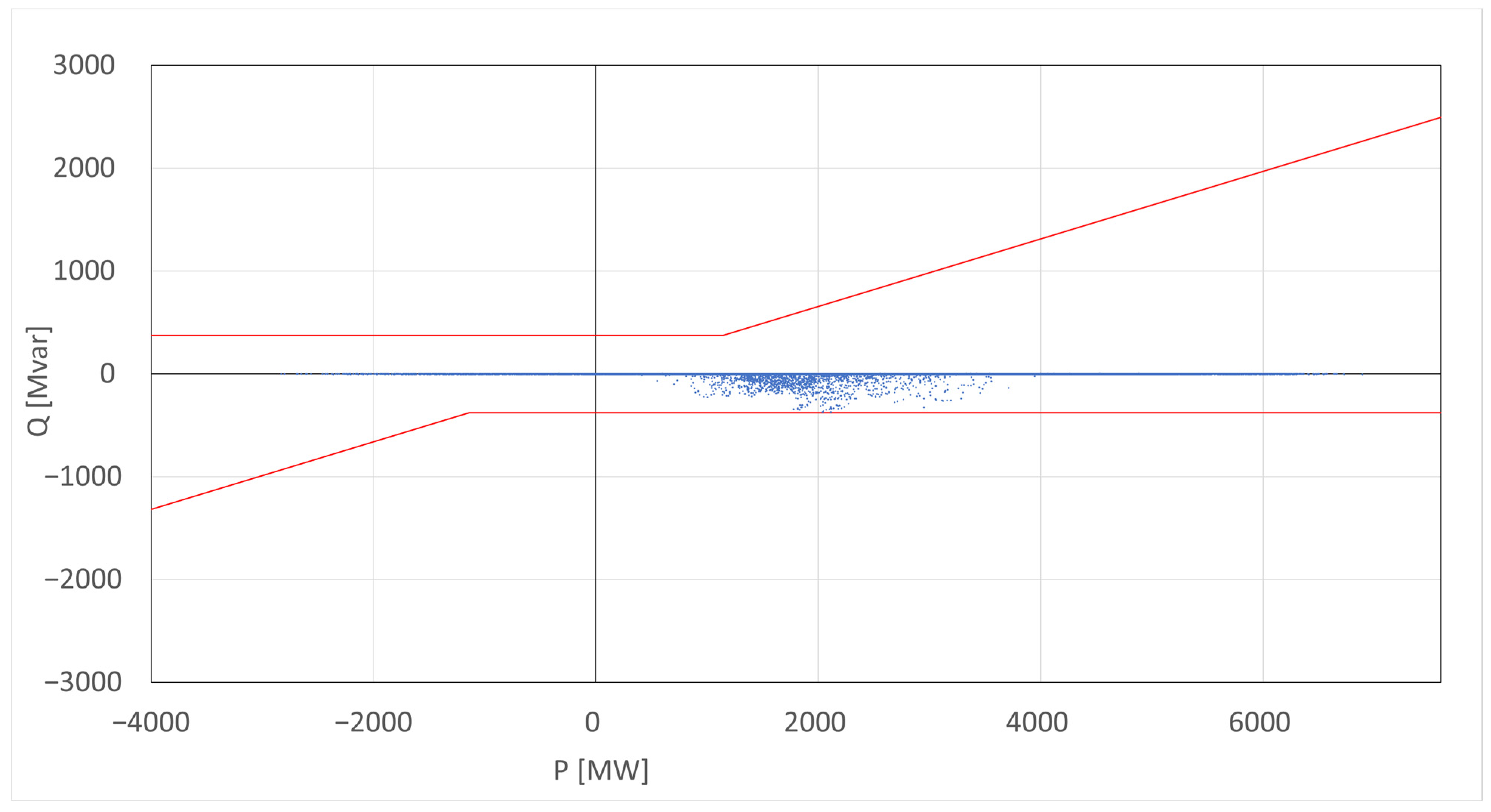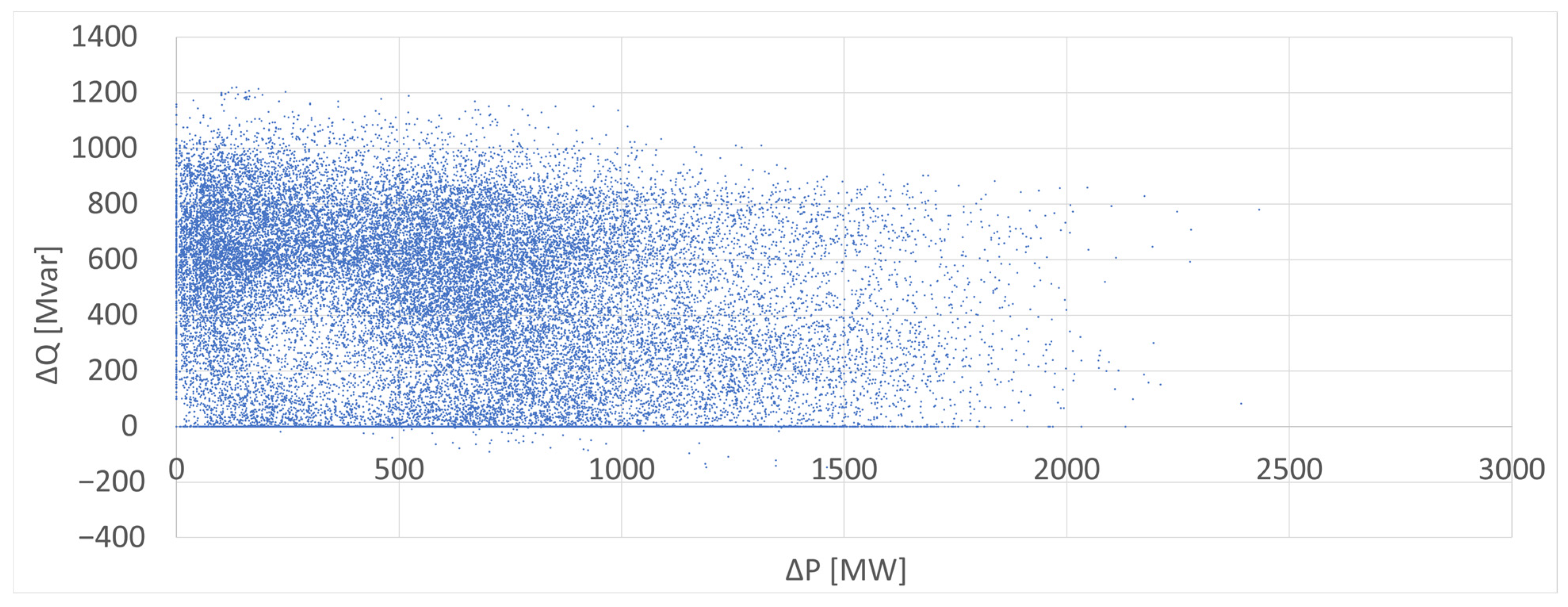1. Introduction
Underground cables, overhead lines, as well as transformers and other parts of a distribution grid can be expressed by their respective equivalent circuit diagrams including capacitive, inductive, and resistive components. Therefore, a 50 Hz distribution grid will have a certain degree of capacitive or inductive reactive power demand. Nevertheless, in recent years, various effects have led the typical reactive power demand of distribution grids to become more and more capacitive. Exemplary reasons for this are the increasing use of underground cables instead of overhead lines and the increasing number of (fundamentally inductive) drives being changed to operation with frequency converters. These and other factors can make a distribution grid violate the reactive power limits determined by relevant standards, as is the case with Bayernwerk Netz GmbH, for example.
The classic, but also expensive and complex, solution to such a problem is to use one or more large compensation coils providing the necessary inductive reactive power. In the age of increasing electric mobility, however, it also seems conceivable to have the required reactive power generated as a “waste product” by a large number of coordinated chargers for electric vehicles. Although the aspect of reactive power provision by electric vehicles or their chargers is not frequently dealt with in the literature, various aspects of it, mainly with regard to voltage stability, but also, for example, with regard to active power losses and transformer aging, have already been examined [
1,
2,
3,
4,
5,
6,
7,
8,
9,
10,
11,
12,
13,
14,
15,
16,
17,
18,
19,
20]. Nevertheless, there has not been any publication on the systemic, across voltage levels and grid-wide use of the same so far. In order to investigate this systemic aspect regarding the reactive power flows at the connection point of different grid voltage levels, several simulations and calculations were carried out using the Bayernwerk Netz GmbH grid as an example. The procedure, assumptions, and numeric methods used are presented in detail below, together with the results obtained showing the potential of the method to make the grid’s reactive power demand meet relevant normative specifications.
2. Materials and Methods
Bayernwerk Netz GmbH operates the low-voltage (0.4 kV, circuit length 3667 km overhead lines and 98,048 km cable), medium-voltage (mostly 20 kV, circuit length 15,924 km overhead lines and 31,677 km cable), and high-voltage grids (110 kV, circuit length 8817 km overhead lines and 321 km cable; see
Figure 1) covering most parts of Bavaria at least in the high-voltage level (roughly 60,000 km
2 and 9 million inhabitants). While the low- and medium-voltage levels consist of individual, galvanically separated grid areas connected only in exceptional cases, the high-voltage grid is continuously meshed throughout the whole grid area of Bayernwerk Netz GmbH and is operated with low-impedance neutral-point grounding. The high-voltage grid has a total of 26 connecting substations with the overlying transport grid (220/380 kV). The high- and medium-voltage grids are connected via 304 substations; the medium- and low-voltage grids are connected via 41,935 local substations. In addition, there are a high double-digit number of high-voltage/medium-voltage substations and a mid-four-digit number of local substations including the respective medium- and low-voltage grids owned by other operators.
The active (P) and reactive (Q) power flows between the Bayernwerk distribution grid and the overlying transport grid are measured using the existing current and voltage transformers and protective relays at the property boundaries between the distribution grid and transport grid located at the low-voltage side of the 220/110 and 380/110 kV transformers. The measurements are recorded at 15 min intervals and summed up across all substations.
Figure 2 shows the results of these measurements across the whole year 2019 (“PQ cloud”, x axis representing active power and y axis representing reactive power). One dot represents one point of measurement. Here, as well as in the following, the load reference arrow system (LRS) is used, meaning that positive reactive power is defined as inductive. Considering the introductory explanations concerning cable lengths within the grid, it is not surprising that the vast majority of points in time fall into the capacitive domain. The red lines represent the reactive power limits described below.
In Germany, the standard VDE-AR-N 4130 specifies the “technical requirements for the connection and operation of customer installations to the extra high voltage network” that also include regulations on the reactive power behavior. Both the inductive and capacitive reactive power, measured at 15 min intervals at the connection point, must not exceed 5% of the contractually agreed maximum active power, with a power factor of at least 0.95 in the inductive range being alternatively permitted above 15% of the agreed active power. These statements apply to active power consumption; in the case of feedback, the standard defines power factor ranges, which the customer must be able to implement on request [
21]. Since, in the case of a distribution grid, the grid operator has only little influence on the reactive power behavior of its connected consumers and since, in the present case, the majority of the points in the PQ cloud are in the area of power consumption anyway, the above-described permissible limits are point-reflected at the origin into the area of negative active power (as applied in
Figure 2). This assumes that the reactive power specifications in the positive active power region are primarily based on the voltage stability requirements in the transmission grid and that an active power of the opposite sign and opposite effect on the voltage thus requires an equally opposite influence of the reactive power. Deviating from these requirements, there may be individual reactive power agreements between distribution grid operators and transmission grid operators or different normative specifications in other countries, which is discussed in
Section 4.
In order to reduce the reactive power demand of its whole grid and thus move the PQ cloud closer toward its limits (see
Figure 2 with the majority of points outside the limits), Bayernwerk Netz GmbH decided to install several compensation coils at substations connecting to the transport grid with the first of them put into operation in 2020. Nevertheless, the method of providing reactive power by electric vehicle chargers was decided to be investigated, as well as a possible future addition to or even replacement for those coils. This analysis was therefore carried out based on the last year without the use of compensation coils (2019).
2.1. Electric Vehicles and Their Chargers
When a battery-electric vehicle is charged from the public grid, the alternating current must be converted into direct current as required for the battery. The rectifier needed for this is located either in the vehicle itself (on-board charger, typically for lower power) or in the charging station (off-board charger, typically for higher power). In contrast to active power, reactive power can generally be provided by the converter circuit itself without the involvement of the battery [
22]. However, the simplest (unidirectional) charger topologies are only capable of operating close to the unity power factor [
22]. For reasons of cost, it cannot be expected that on-board chargers will be designed for significantly higher apparent power than necessary for charging the vehicle; the same applies to the topology of the power electronics with respect to the possible range the power factor can take. Both aspects limit, directly and indirectly, the possibility of providing reactive power. Since it is unrealistic that car manufacturers will install more versatile converters for the sake of grid services, it is assumed that, when using an on-board charger, a power factor between 0.9 and 1 can be achieved during the charging process. Time periods at which the charging process is finished but the vehicle is still connected to the power grid are not considered since no reliable statement can be made about their length.
In the case of off-board chargers, it cannot be assumed either that they support arbitrary power factors without further ado. However, it is much easier for a grid operator to negotiate the availability of such a service by appropriate circuit design (e.g., four-quadrant topology [
22]) with the charging point operators. Consequently, a power factor of no less than 0.9 is assumed during the charging process of a vehicle for similar reasons as above, whereas without a charging vehicle, it can take any value.
According to the German Federal Network Agency, the ratio between public normal charging points (22 kW or less) and fast charging points (more than 22 kW) in Bavaria was about 7:1 at the beginning of 2022 [
23]. It is assumed in the context of this publication that this ratio will continue to be valid in the future. Charging power of up to 22 kW is usually achieved in European vehicles using a three-phase connection (an on-board charger) [
24] (p. 228); higher power, on the other hand, is achieved with off-board chargers. This subdivision is also assumed to continue to be valid. Furthermore, the German federal government estimates that the ratio of private and publicly accessible charging points will be between 60/40 and 85/15 in 2030 [
25]. As a result of all those ratios, it is assumed that there are 350 public AC charging points (22 kW) and 50 public DC charging points (50 kW) for every 1000 private charging points.
2.2. Time Series of Vehicle Chargers Power Consumption
Wagler developed a time series generator script for the charging power of battery-electric cars covering the driving behavior over the course of a whole year based on the assumptions that the car starts a journey at most once a day, returns to the charging station at the end of the driving cycle, and is immediately charged. There is a realistic driving time between departure and return, and the car is not parked at the usual charging point for a maximum of 16 nights a year [
26]. Some assumptions adjusting for today’s battery-electric vehicle market conditions, including a common charging power of 11 kW for all vehicle types, were made in comparison with the vehicle properties in [
26]; nevertheless, this is considered a negligible influence since, as shown below, the private charging points only make a comparatively small contribution to compliance with the reactive power limits. On this basis and using the aforementioned generator script, 100 random time series for the active power demand of private charging points were obtained.
Because of the lack of existing available time series, synthetic time series are used for the public charging points. Both public AC and DC charging points are assumed to serve two charging vehicles per day, with each charging process lasting 45 min (based on simplified statistical data for ca. 9000 public charging points in Germany in 2021 [
27]). The points of time when those charging processes start are randomly determined, with an elevated probability between 9 am and 6 pm in order to reflect the common daily routine of the majority of the population. The charging power is assumed to be 22 kW for public AC and 50 kW for public DC chargers with 100 different random time series being available for both. These time series, such as those mentioned above according to Wagler, have a 15 min resolution and cover a whole year to allow addition to the existing PQ cloud.
2.3. Possible Alteration of Reactive Power Flow on Its Course through the Grid
In practice, grid equipment such as transformers, cables, and overhead lines has inductive or capacitive properties in addition to ohmic losses. Therefore, it is conceivable that reactive power fed in by vehicle chargers at the low-voltage level experiences an increase or decrease on its way through the medium- and high-voltage levels up to the transport grid. While the former case is not critical and can be remedied by throttling the converters in question, the latter case can, under unfavorable circumstances, result in a previously made calculation no longer being correct and a part of the reactive power requirement remaining uncovered. This aspect is of particular importance since most of the reactive power requirement comes from the medium- and high-voltage levels.
The aforementioned amplification or weakening effects of the reactive power depend not only on the structure of a grid but also strongly on its workload [
28] (p. 55); in addition, the grid topology is subject to changes, for example, because of switching operations. This makes it difficult to make abstract, general statements about a typical or maximum level of the mentioned effects. A simulation of a typical grid model from the low-voltage level up to the connection to the transport grid with different active and reactive power workloads resulted in amplification effects of up to 80% and weakening effects of up to 5% (observed through all voltage levels), both with respect to inductive and capacitive reactive power [
28] (p. 55), which, in the case of reactive power, can be transferred to the feedback case. In addition, various extreme cases within the Bayernwerk Netz GmbH high-voltage grid, such as high power demand, high feed-in, and also the highest conceivable reactive power flow from/into the transmission grid, were modeled using INTEGRAL simulation software. It was investigated which changes happen to inductive or capacitive reactive power in the range between 5 and 20 Mvar flowing through the said grid under these circumstances. The greatest discrepancy observed was 18%.
In the context of this article, a pass-through factor of 0.8 was therefore chosen as a conservative assumption; this means that only 80% of the reactive power—both capacitive and inductive—fed in at the low-voltage level will reach the connection to the transport grid. In contrast, active power losses were neglected, as they typically do not exceed the low single-digit percent range.
2.4. Simulation Process
Figure 3 shows the procedure for the simulation, which is carried out as an iterative process. A parallelogram represents both input and intermediate data within the simulation algorithm; the plus sign describes the addition process (of the same points in time). At the beginning, active power time series are drawn for the charging points. A total of 100 different time series are available for each type of a charging point, from which one is randomly selected. In order to keep the calculation effort within reasonable limits, each iteration adds 1000 private, 350 public AC, and 50 public DC charging points of the same time series. The charging power of all those time series is subsequently added to the active power of the PQ cloud. If the PQ cloud exceeds reactive power limits, reactive power is provided within the limits of the respective charging points described above. If all limits are met after this step, the simulation is ended. Otherwise, it continues with another iterative run.
In addition, an alternative procedure is used in which reactive power is provided to not only meet the limits but also shift those points that already comply with the limits as far as possible into the direction of pure active power by providing further reactive power.
4. Discussion
As mentioned in
Section 3.2, compliance with the reactive power limits, assuming a constant ratio of the types of charging points to one another, would be achieved with a number of about 600,000 private charging points. When comparing this number with the number of inhabitants in the whole Bayernwerk grid area (
Section 2), it becomes obvious that this is by no means an unrealistic assumption; it would merely mean one private charging point for every 10 or more inhabitants. Especially with regard to the political goals in Germany and the European Union, which, at least with regard to passenger cars, promise an almost complete switch to battery-powered mobility in the next few decades, it can be assumed that there will be a significantly larger number of charging facilities than described above. Furthermore, the 50 kW charging power of the public DC charging points was set rather conservatively, considering that public fast charging points with more than 100 kW power are already available today and that a further power increase is to be expected, which would be accompanied by a corresponding growth in reactive power capability. This would result in an even smaller number of public DC charging points necessary for the reactive power limits to be met.
On the one hand, this provides an additional safety margin in the event that the provision of reactive power in individual local grids has to be throttled due to the load on the transformer, although this is not expected to frequently happen since the severity of reactive power limit violation decreases with an increasing active power demand (
Figure 2). Another reason for a lower-than-possible provision of reactive power in a local grid can be an otherwise impermissibly high or low voltage caused by the reactive power, although this would, based on the experience of Bayernwerk Netz GmbH, only be expected in rather rural radial grid topologies. On the other hand, in addition to complying with the reactive power limits of the transport grid operator, this circumstance also enables the provision of reactive power as a system service to the transmission grid. This is more important today than ever before as large coal and nuclear power plants, whose generators have mainly provided the required reactive power so far, are increasingly being taken off the grid. Moreover, this also enables a generalization of the previous conclusions to grids with possibly stricter applicable reactive power limits and/or with a different grid structure.
The downside of this approach is a higher (apparent) load level of the distribution grid due to the transport of reactive power, which subsequently can lead to higher (active power) grid losses. While the settings in
Section 2.1 were made in such a way that the car owners remain unaffected in their charging and driving behavior, the provision of reactive power naturally also generates active losses within the converters. In both cases, financial compensation for the additional losses would be necessary. Nevertheless, it can be assumed that these are hardly significant compared with the expenses that would otherwise have to be incurred for the provision of reactive power (e.g., large coils causing active power losses as well). Last but not least, there would be additional effort for installing and keeping up data connections between the grid operator and all charging points involved unless such capabilities are already provided because of other reasons, e.g., due to increasing flexibility and digitalization demands to the grid. In contrast, there is no risk of additional wear of the electric vehicles’ batteries since the reactive power is provided by the converters themselves.
5. Summary
The current political and social framework conditions in Europe, and particularly in Germany, present the power grid with unprecedented challenges: Conventional large power plants, the mainstay of the power grid for decades, are being shut down in large numbers, and renewable energy sources are taking their place; at the same time, a rapid increase in the demand for electricity for passenger cars is to be expected. An unparalleled grid expansion is necessary. Still, this article shows that an advantage can be drawn from the controlled interaction of both factors with regard to the reactive power balance and, thus, the stability of the grids. The loss of the stabilizing function of the power plants for the grid can be compensated for by the controlled interaction of a large number of charging devices for electric vehicles, without this causing inconvenience to the vehicle users. The aggregated use of the otherwise unexploited reactive power potential of vehicle chargers’ power electronics with and without a charging vehicle allows for the distribution grid’s normative reactive power specifications to be met. Furthermore, it enables the provision of additional reactive power to the transport grid. This also takes into account the possible alteration of the reactive power flow on its course from the low-voltage up to the high-voltage level of the distribution grid. The most important—and indispensable—contribution comes from public DC charging stations; it is therefore highly advisable for distribution grid operators to strive for extensive reactive power capabilities of these charging stations already today, in the early days of the spread of electromobility.

